Tom's Guide Verdict
A Leica-engineered rear camera that produces crisp, colorful images highlights Huawei's P9, but the phone's lackluster battery life keeps it from being a top pick.
Pros
- +
Terrific dual Leica camera
- +
Bright, colorful display
- +
Good performance
- +
Nicely positioned fingerprint reader
Cons
- -
Subpar battery life
- -
Ho-hum specs compared with similarly priced phones
- -
Slick edges make the phone hard to grip
Why you can trust Tom's Guide
When considering the Huawei P9, it's tempting to think only of the flagship phone's camera. After all, this $630 unlocked smartphone boasts a dual-camera setup engineered by the venerable Leica, which results in impressively detailed and clear photos.
But there's more to the P9 than just what it snaps. Huawei's latest device showcases enough stellar features, including a handy fingerprint sensor and a peppy processor, to make it a worthy choice. Unfortunately for Huawei, similarly priced handsets simply offer more, especially when it comes to battery life.

To help you decide if this is the phone for you, here's what the P9 gets right and where it misses the mark.
WHAT THE P9 GETS RIGHT
The Camera Is As Good As Advertised
Developed by Leica, the 12-megapixel rear camera features two f/2.2 lenses that capture color information and monochrome detail. Working in tandem, the two lenses should produce bright colors and sharp images. They also combine to create a pixel size equivalent of 1.76 microns. To put that pixel size in context, the individual pixels in the Galaxy S7's camera are 1.4 microns, and that's one of the reasons that camera excels at taking photos in low-light.
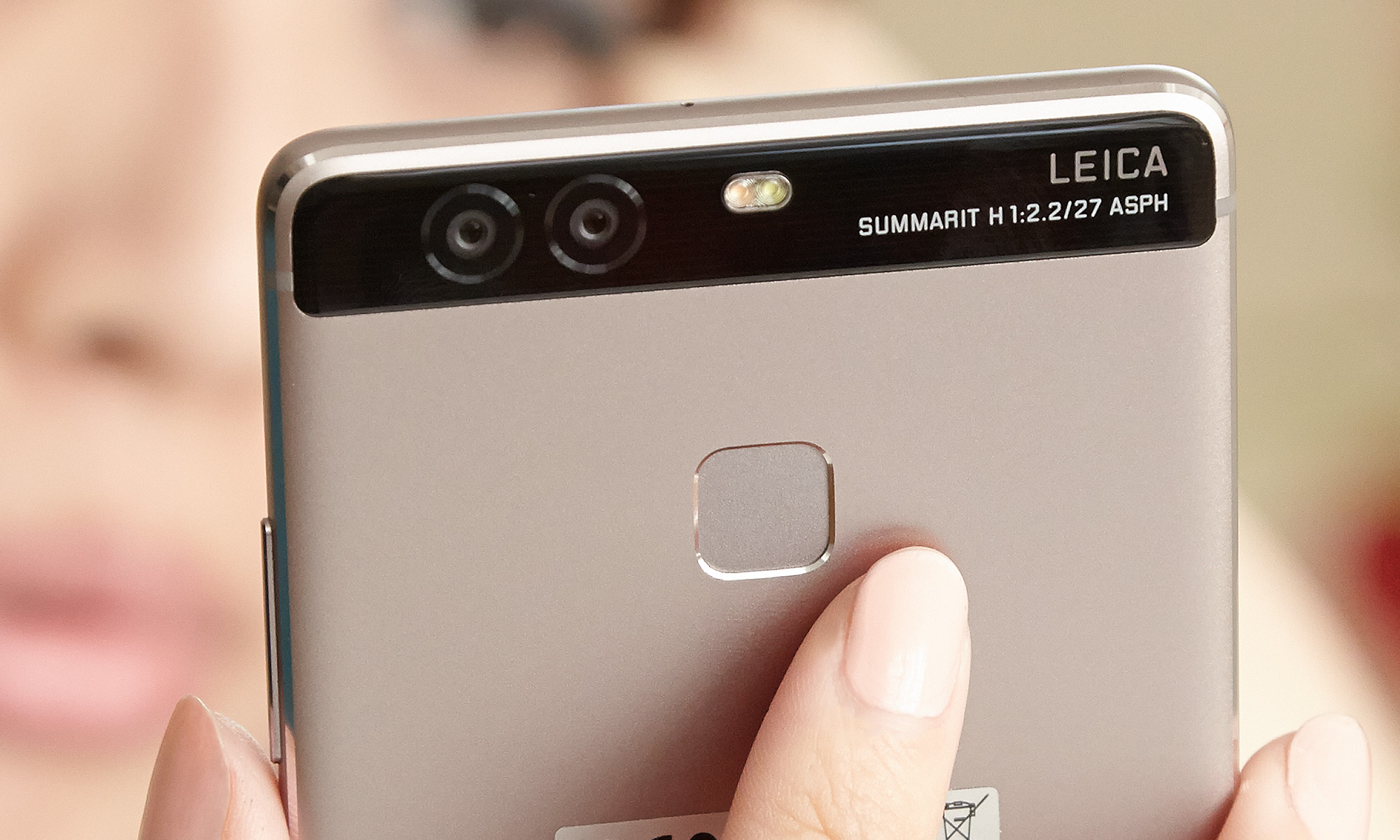
You can see the impact the P9's dual-camera approach has in many of the photos you'll take with the phone. A photo I snapped of a friend during lunch does a good job of contrasting the part of his face that's bathed in natural light flooding in from the restaurant's window with the shadows cast by the restaurant's lighting. Other cameras might have washed out his face or made the shadowy parts too dark, but you can make out all the details here.

Speaking of an eye for details, the P9's camera really captured the individual textures of each petal from a rose growing in my garden. You can also spot beads of rain on those petals from a sudden May downpour.
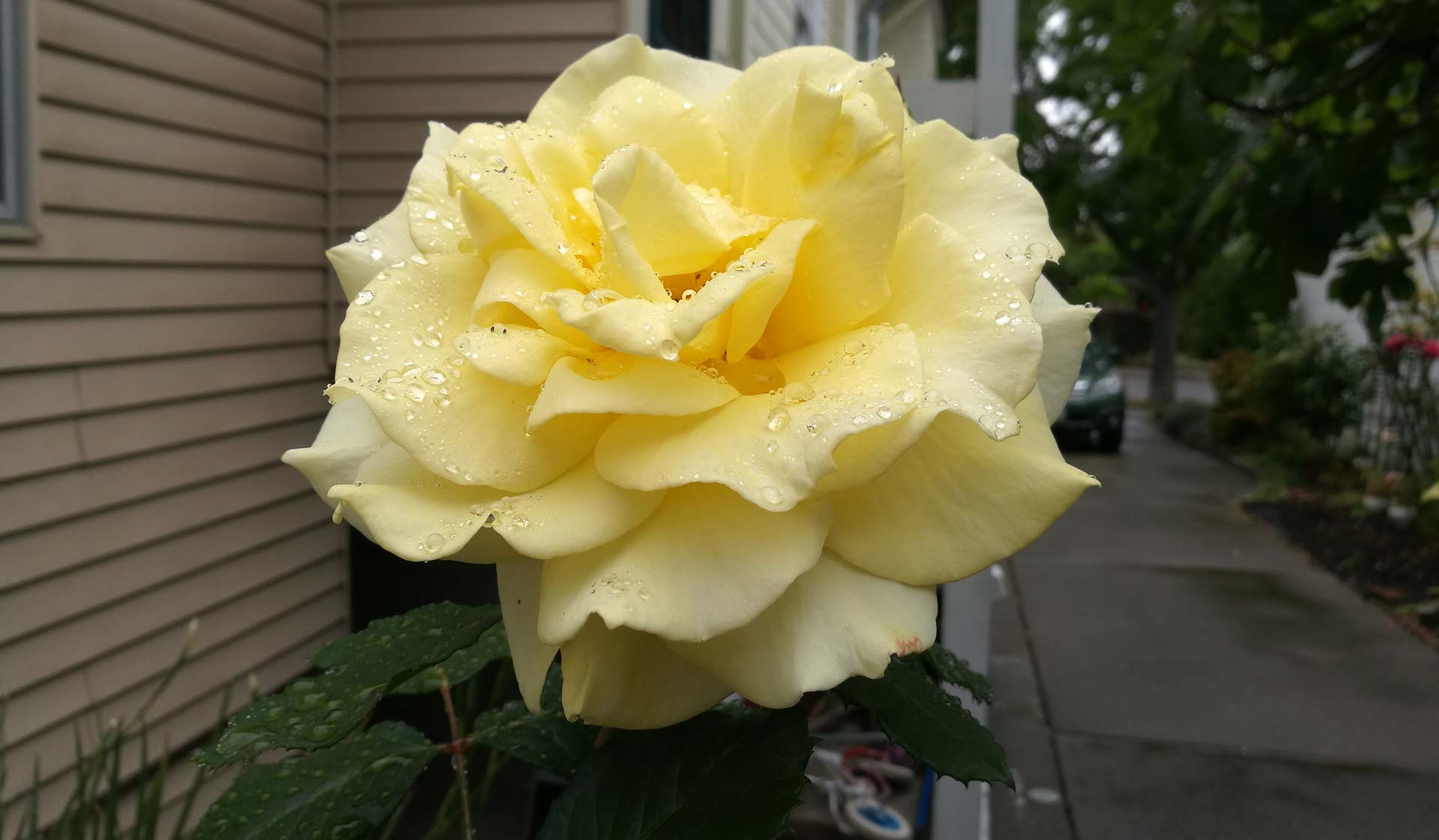
I had less success in darkened rooms. My home office doesn't get a lot of natural light, so my collection of miniature baseball caps appeared dark and fuzzy when I took a photo with the P9's flash turned off.
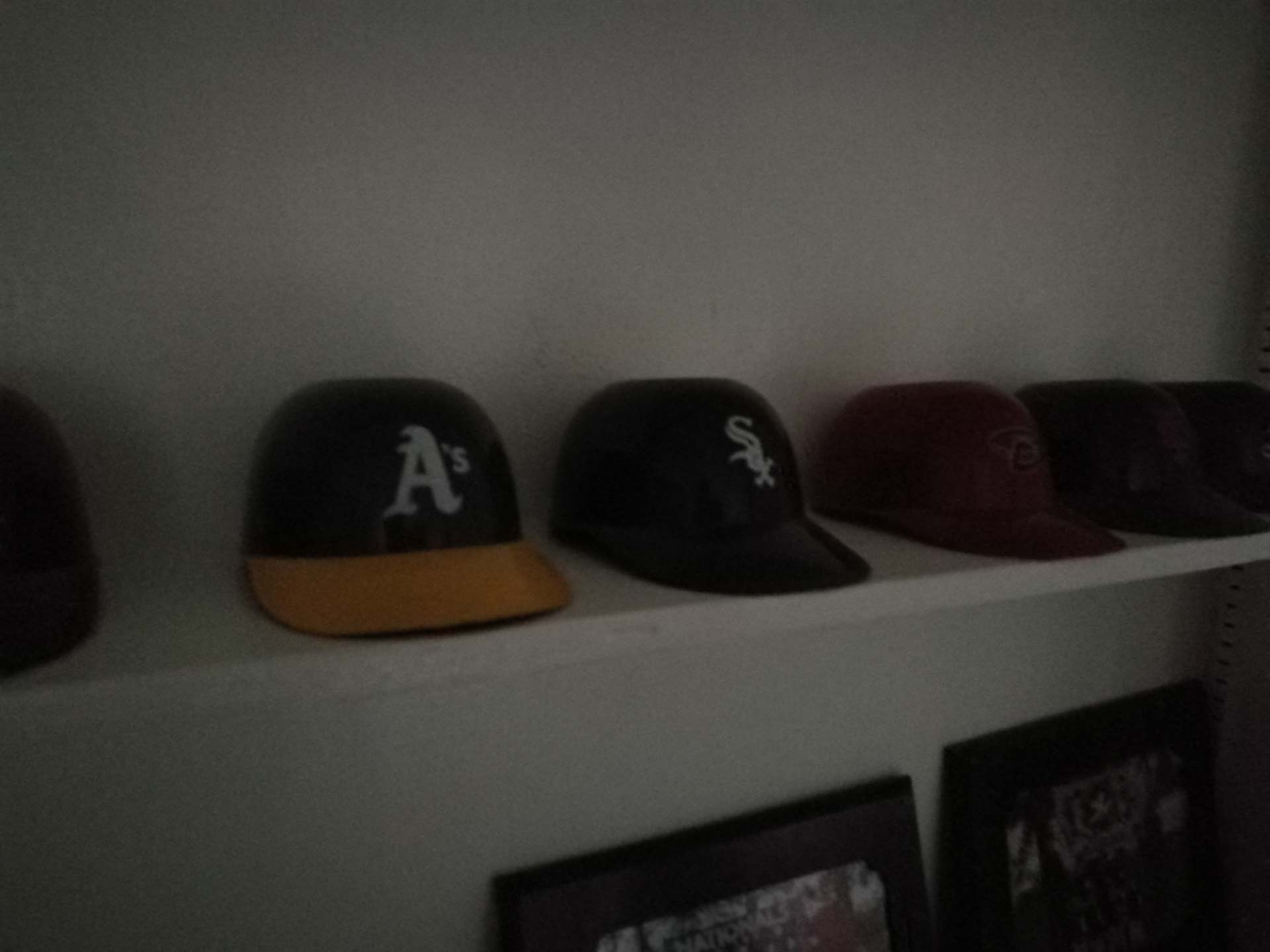
Things improved considerably when I used the flash: you can identify the different colors of the Athletics, White Sox and Diamondback caps, though the edges of the hats aren't as sharp as they could be.
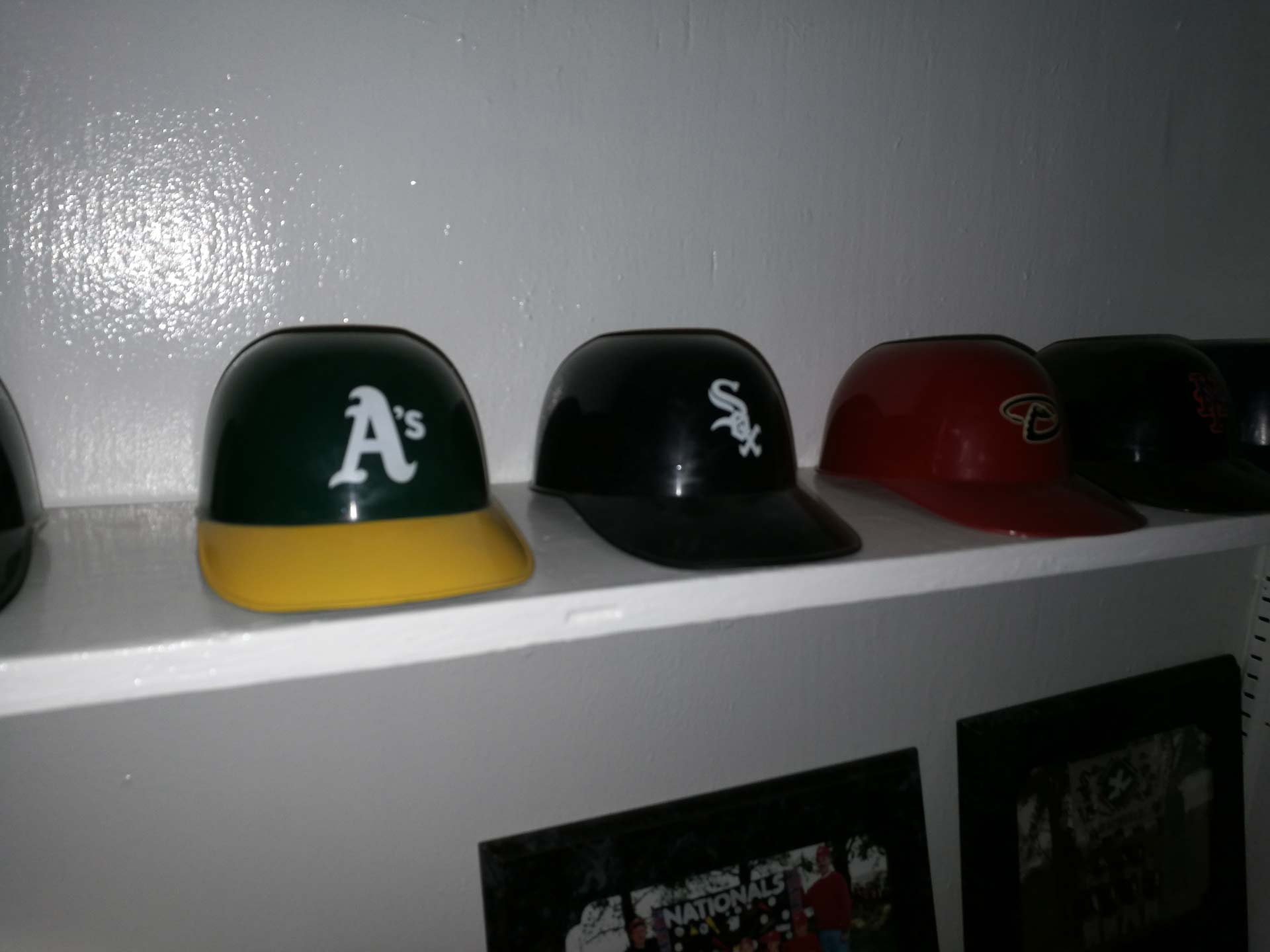
My colleague Cherlynn Low had better luck with the P9's camera in less-than-favorable light, capturing a detailed view of a Manhattan skyline at dusk. Individual buildings stand out and traces of light and shadow give the photo a very stylized look.
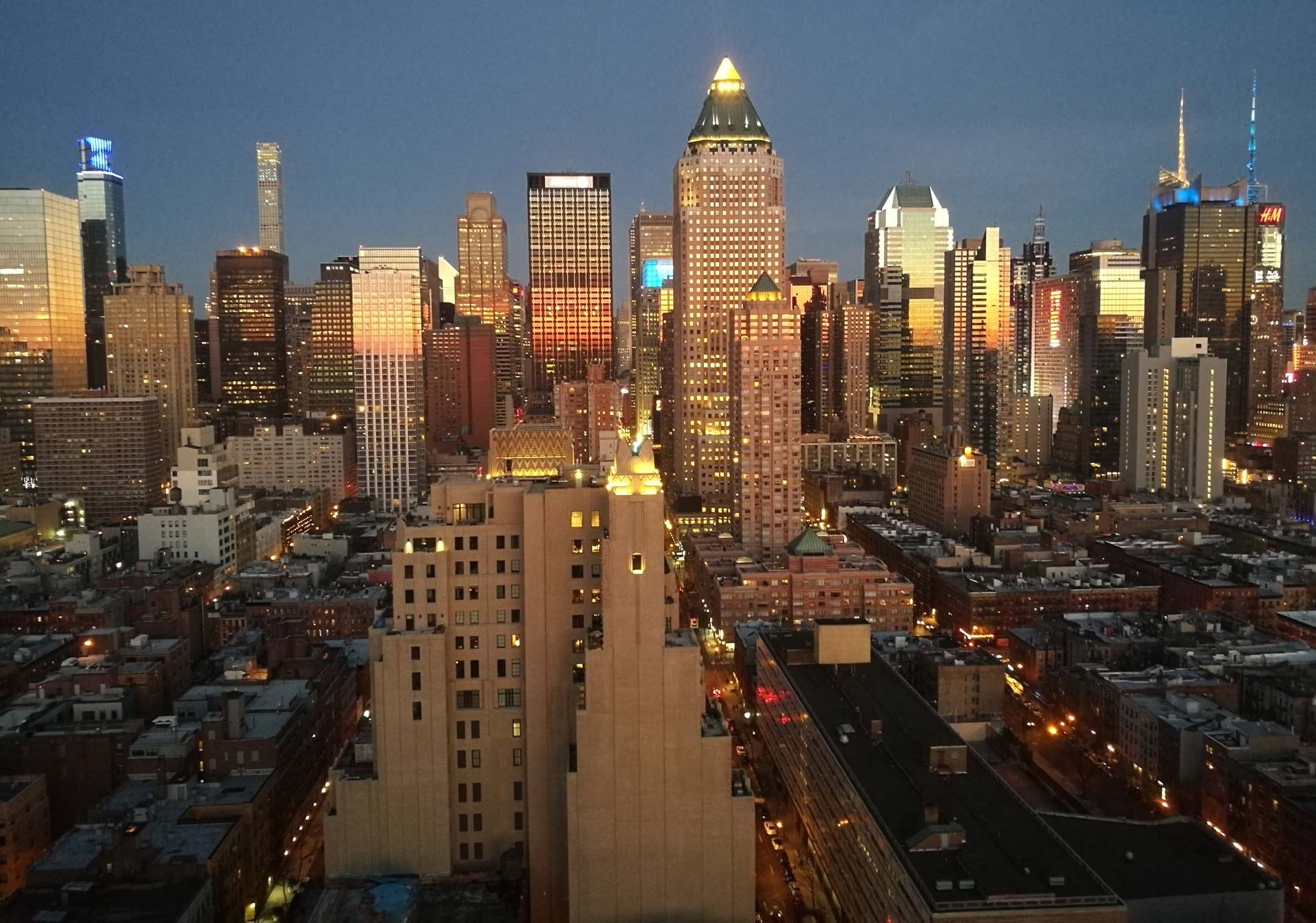
Photo enthusiasts should appreciate the various modes that Huawei has built into its camera app. Swipe right on your screen and you can summon up a menu of a dozen different modes, including monochrome, HDR and panorama. An All-Focus feature lets you change the focus shots after you've taken a picture, which we used to strong effect on a photo of a breakfast platter.
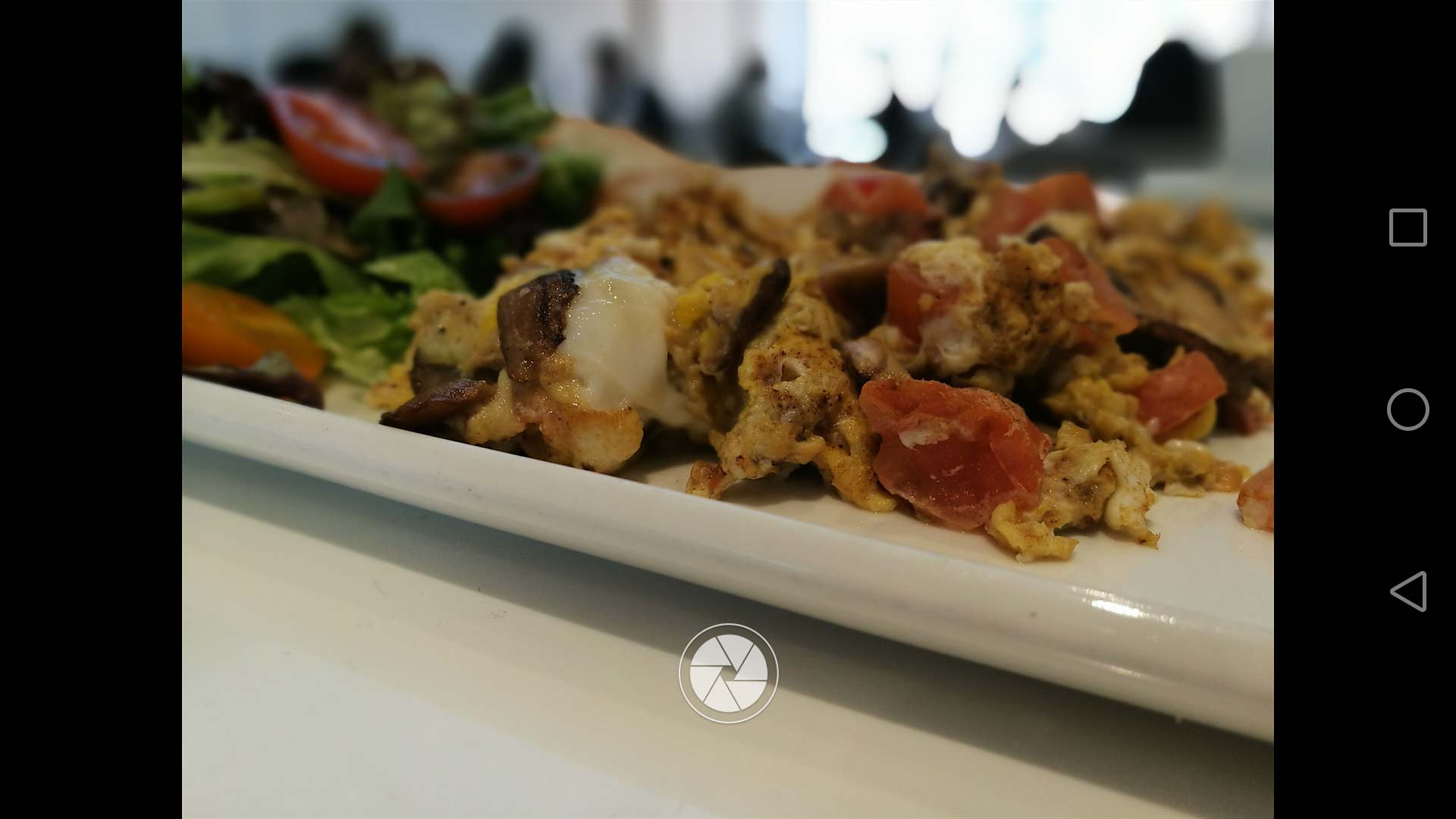
The P9 can shoot HD video in either 1080p or 720p. You'll be pleased with the results: in a short clip of my daughter sprinting down a sidewalk, she stayed in focus the whole time, as did passing cars.
The 8-MP front camera produced better selfies than I'm used to, with even my stubble standing out as sharply as my purple T-shirt. The front camera features a Beauty mode that's set to 5 by default, which will make your skin look a little smoother; dialing Beauty mode down to 1 will reveal a few more blemishes, though the final shot looks a little more realistic to my eye.

All told, it's a very impressive camera, though it's not the best camera available on a smartphone. That would be the one found on the Galaxy S7, which outperformed the P9's camera in our head-to-head showdown between the two phones.
The P9's Fingerprint Sensor Comes In Handy
Huawei tucked the fingerprint reader on the back of the P9, a design decision I appreciate, since I find it more natural to use a finger on the hand that's holding the phone. Just keep in mind that you won't be able to unlock the phone when it's lying flat on a desk.
MORE: Best Smartphones on the Market Now
The fingerprint sensor does more than just provide another layer of phone security. Press and release the sensor when the Camera app is running, and you can snap a photo — useful for taking a selfie. In the Gallery app, I could swipe sideways on the sensor to scroll through photos, which gives me a more unobstructed view of what I've shot. And a downward swipe on the home screen summons up a list of notifications that I can dismiss with another swipe. It's a clever way of adding more capabilities to the sensor that you'll actually find yourself making use of.
This Phone Packs a Lot of Power
Huawei uses its own processor in the P9, and the octa-core Kirin 955 offered plenty of pep during daily use. Apps launched quickly, video streamed on Netflix without any lag, and I was able to blow away baddies in a processor-intensive game like Modern Combat with ease. The P9 can handle nearly everything you care to throw at it, even if other phones in its price range turn in better benchmark scores.
The P9 notched a score of 4,959 in Geekbench 3, which tests overall performance. That beats the average phone but falls behind the Galaxy S7 and LG G5.
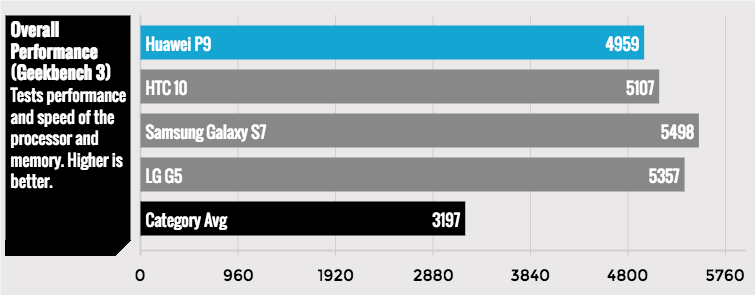
The story's the same for graphics, where the P9's 15,7662 score on 3DMark Ice Storm Unlimited also topped the average smartphone but not the latest from Samsung and LG.
The P9 really impressed in our video conversion test, in which we make the phone convert a 204MB video from 1080p to 480p. The P9 pulled that off in 2 minutes, 23 seconds, more than a minute better than LG's G5 (3:31) and the HTC 10 (3:50).
The P9 Sports a Gorgeous Display
The 5.2-inch screen looks big and bold, letting you drink in every detail from images and videos. Details popped in a clip from Captain America: Civil War, and I was even able to view the video from the side without any ill effects.
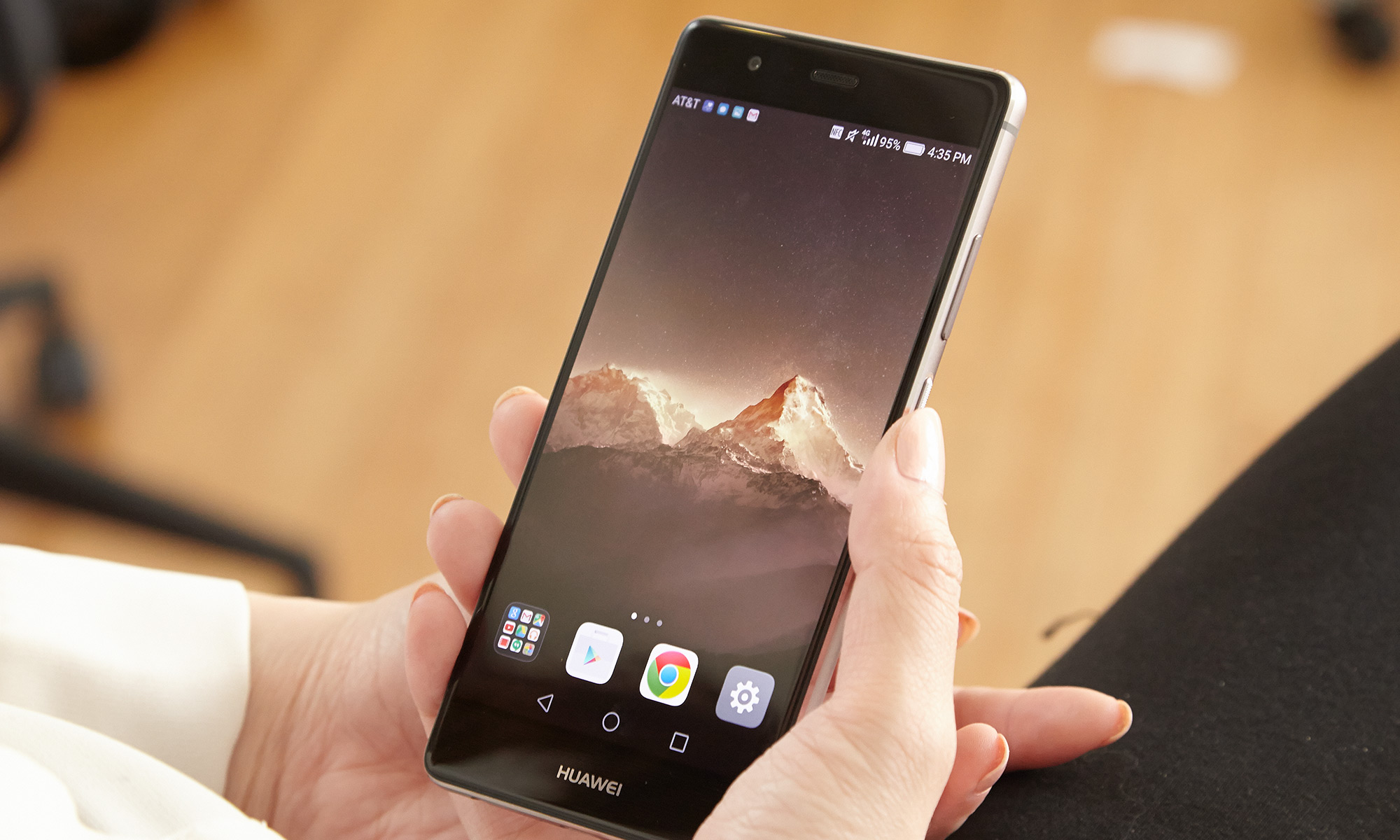
Credit the P9's bright display, which we measured at 521 nits with our light meter. That's not only better than the average smartphone (431 nits), it's also brighter than any other phone in the P9's high-end class, with only the Galaxy S7 Edge beating it (537 nits). That brightness helps keep the P9’s screen visible even when you're outside, though you'll need to max out the brightness setting on very sunny days.
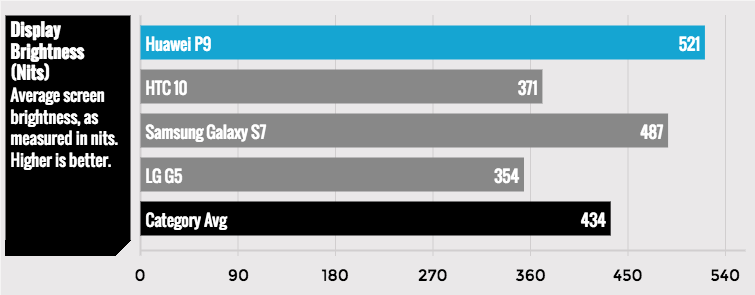
The P9's display also handles colors well. It shows off 170.6 percent of the sRGB color gamut, compared with 134.9 for the average smartphone. In color accuracy tests, the P9 scored a 1.22 Delta-E rating, compared with 2.90 for the smartphone category. (Numbers closer to zero are better in this test.) Other phones outperform the P9 in these two areas — the S7 has a 196.6 percent color range and the iPhone 6s has a near-perfect Delta-E rating of 0.4 — but you won't have many complaints when looking at Huawei's new phone.
WHAT THE P9 GETS WRONG
Similarly Priced Phones Have Better Features
Let's start with the otherwise standout display: The P9 offers 1920 x 1080 resolution. A full-HD display is nothing to sniff at — it's the same resolution you'll find on the iPhone 6s, for example — but we live in day and age of higher-resolution screens. The LG G5, Galaxy S7 and HTC 10 all boast displays with 2560 x 1440 resolution, and as good as the P9's screen looks, you wonder why its resolution can't match these similarly priced phones.
MORE: Huawei P9 vs. Galaxy S7: Even a Leica Can't Beat Samsung
That same issue also crops up when comparing the P9's performance to other phones in its class. As I mentioned, the P9 performs well; other phones perform better. Of the high-end phones we can compare to the P9 only the iPhone 6s turned in a lower Geekbench score. And the P9 had the lowest 3DMark score by far when compared with the iPhone 6s, Galaxy S7, HTC 10 and LG G5.
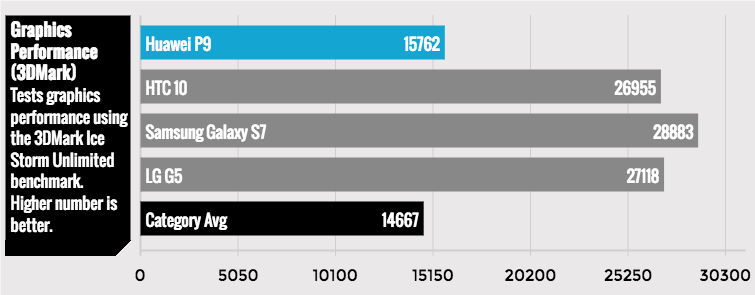
That may not be something you notice in everyday use. I was perfectly happy with how the P9 fared during my time with the phone. But phones don't exist in a vacuum, and when you spend $630 on a device, you have a right to wonder why it's outpaced by the competition.
The P9's Design Is Pretty Lackluster
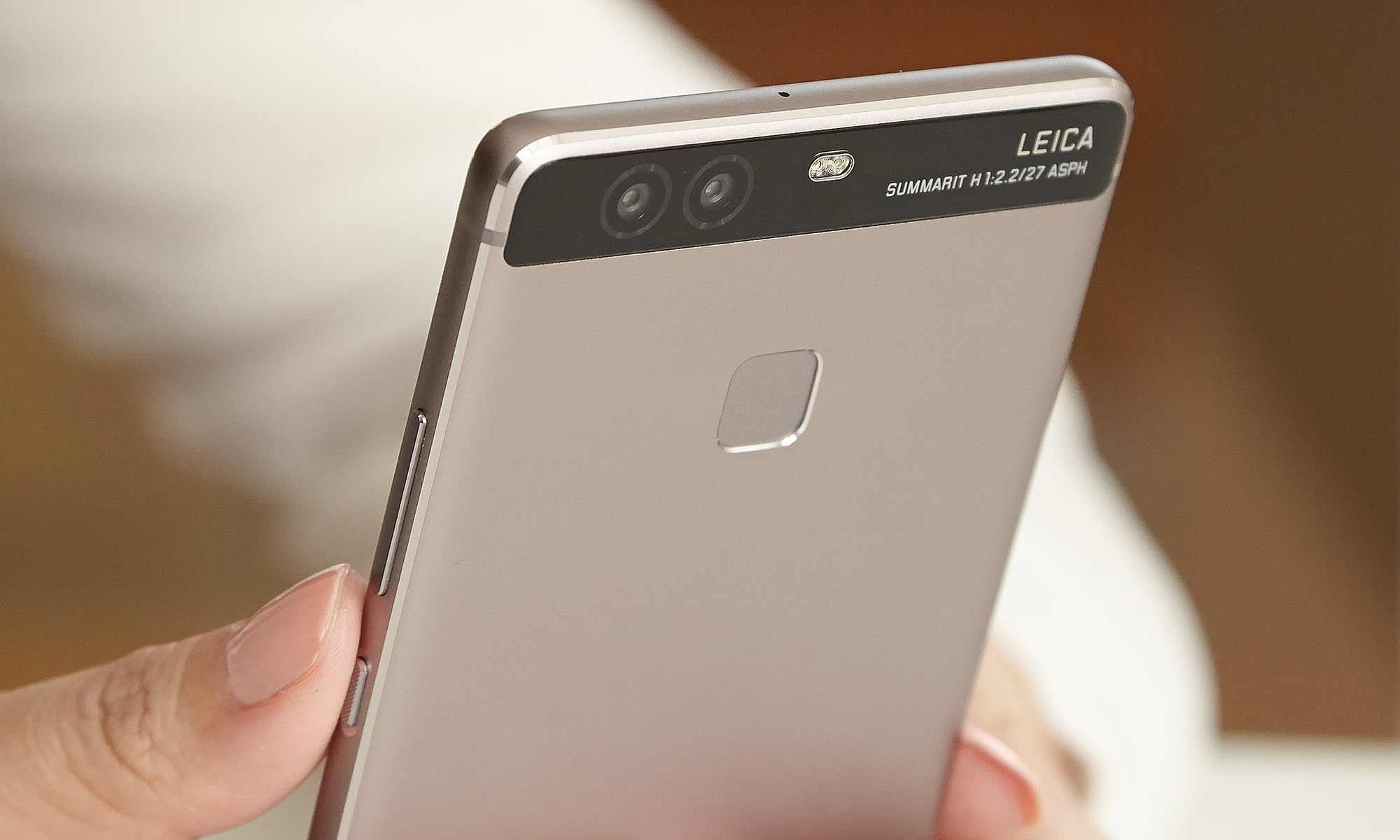
You can choose from a host of colors for the P9 — silver, gray, white and three different variations of gold, including the ever-popular rose gold. But that's about the only way the P9 stands out: it looks like any other smartphone, without any of the design flourishes that characterize the S7 or the iPhone 6s.
The edges of the phone feel slightly curved, which made it feel like the phone was constantly in danger of squirting out of my hand.
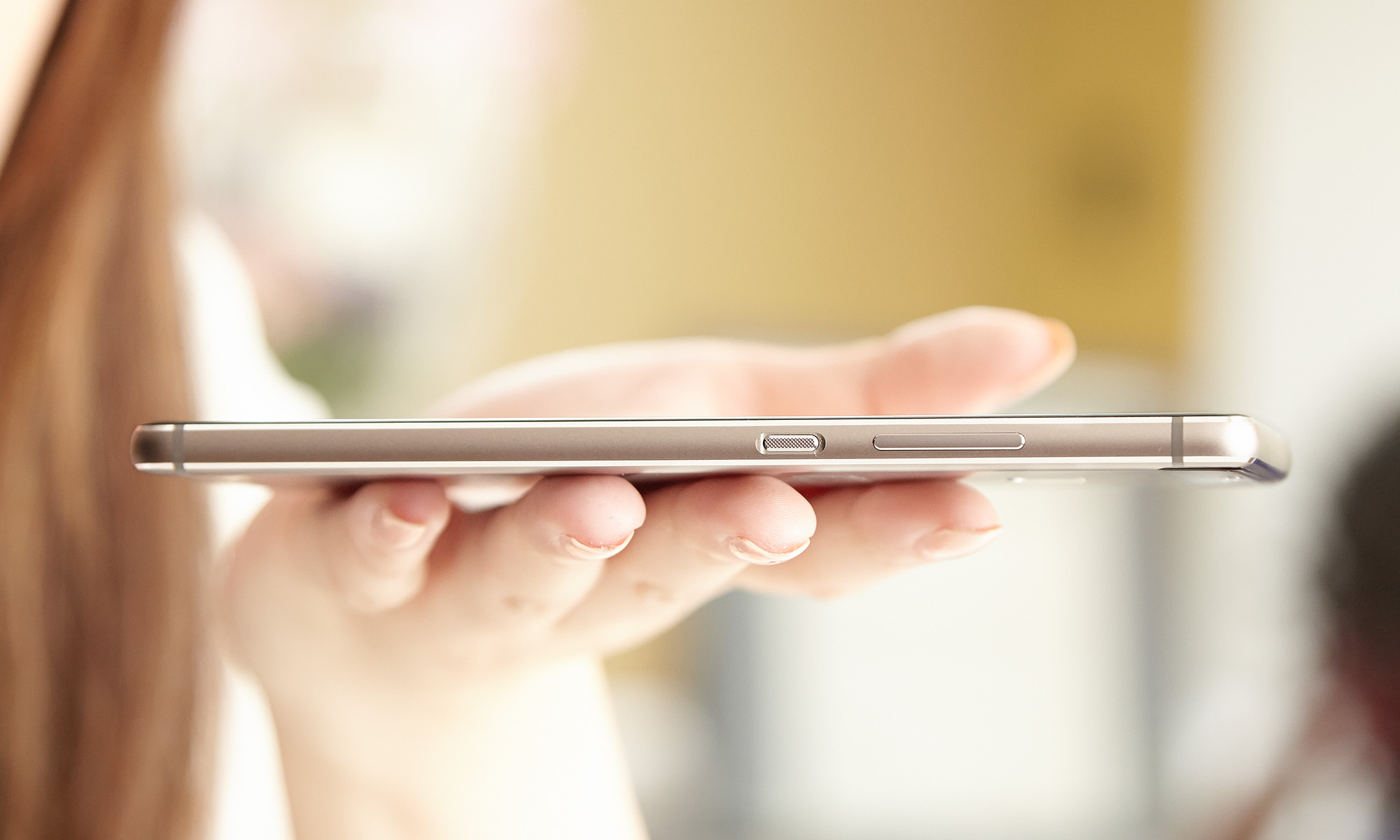
The P9 is a rather ordinary mix of glass and metal. The back of the phone features your solid color of choice save for a strip at the top where the Leica camera lives. The edges of the phone feel slightly curved, which made it feel like the phone was constantly in danger of squirting out of my hand. Huawei could have come up with a more clever way of letting you grip its phone.
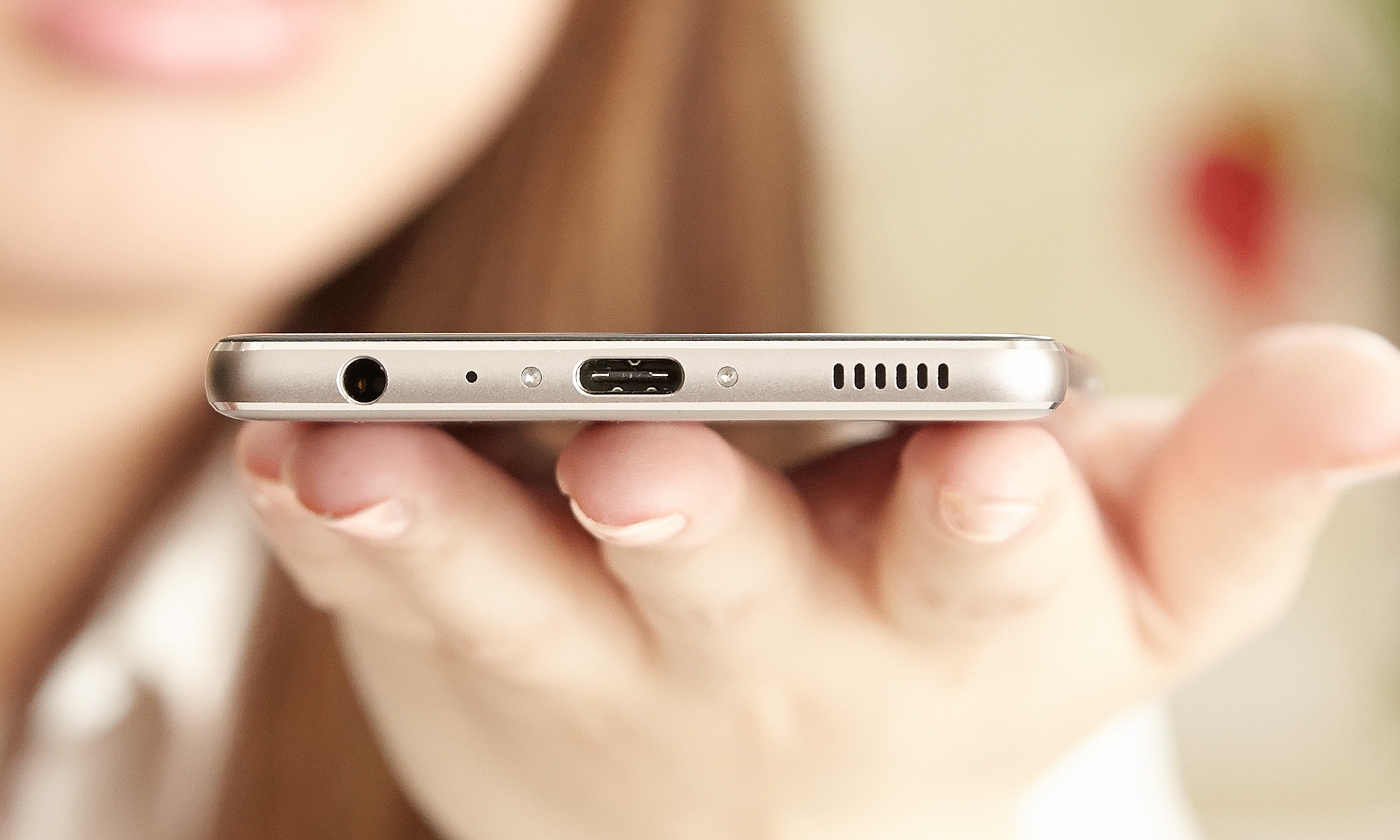
Huawei placed the P9's speaker on the bottom of the phone. It produces decent sound when you're watching a video or listening to music. But hold the phone in landscape mode and you're prone to covering up the speaker, which produced muffled sound during my Modern Combat gaming sessions on the P9.
Battery Life Doesn't Measure Up
A 3,000 mAh battery powers the P9, so it's surprising that the phone fared so poorly in our battery test. Surfing the web over AT&T's 4G LTE network with its display set to 150 nits of brightness, the P9 lasted for just 6 hours and 33 minutes. That's nearly 2 hours less than the average smartphone and well behind both the Samsung Galaxy S7 (10:09) and the HTC 10 (9:56). I swapped in a T-Mobile SIM card to see if that might improve the P9's performance. It did, but only slightly — running our battery test over T-Mobile's 4G network, the P9 lasted 7:10. That's still below the category average of 8:25.
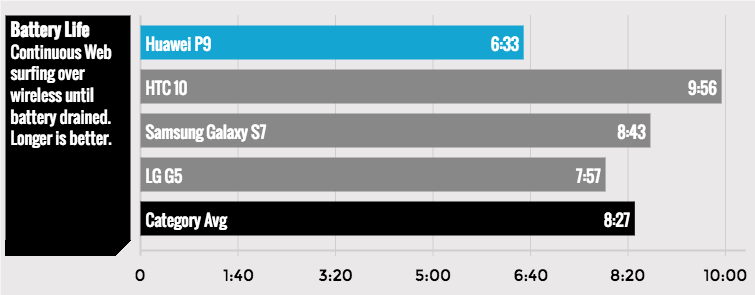
It's not all terrible news for the P9 on the battery front. I went to bed one night with the phone down to just above 50 percent of its battery; when I woke up in the morning, I still had a 40 percent charge, so you don't lose a lot of juice when the phone isn't in use. But put the phone through its paces by running some apps, and that battery life will start to flag fairly quickly.
The Latest Android But with Bloat
You'll get an up-to-date OS if you opt for the P9. It runs Android Marshmallow. But you'll also get a lot of unwanted apps. In addition to a folder full of Google apps, Huawei includes a folder of its own offerings, some of which duplicate the apps built into Android. Another Top Apps folder contains even more selections — some useful (Twitter and Facebook), some not (Booking.com).
MORE: The Best Android Apps to Try Today
Bottom Line
There's a lot to like about the Huawei P9, particularly if you focus on its outstanding camera. The Leica-engineered two-camera setup delivers crisp, detailed shots along with several modes that should please more demanding photographers. The trouble is, Samsung's Galaxy S7 phones sport powerful cameras, too — and those devices have enough battery power to put in a full day's work and play.
The P9 does some other things well, including its versatile fingerprint sensor, but its subpar endurance means you should consider Android alternatives before you fork over this kind of money.
Specs
Carrier: Unlocked
Display Size: 5.2 inches
Display Resolution: 1920 x 1080
CPU: Kirin octa-core 955
RAM: 3GB
Storage: 32GB
Bluetooth Type: Bluetooth 4.2
Wi-Fi: 802.11 a/b/g/n/ac
Rear/Front Camera Resolution: 12 MP / 8 MP
Size: 5.7 x 2.8 x 0.27 inches
Weight: 5.07 ounces
Philip Michaels is a Managing Editor at Tom's Guide. He's been covering personal technology since 1999 and was in the building when Steve Jobs showed off the iPhone for the first time. He's been evaluating smartphones since that first iPhone debuted in 2007, and he's been following phone carriers and smartphone plans since 2015. He has strong opinions about Apple, the Oakland Athletics, old movies and proper butchery techniques. Follow him at @PhilipMichaels.
-
Deserves a lot more rating then just a "7" i get mine today, I heard its the best phone in the hands, so maybe your hands are to small. The battery could improve if you tweak it up the settings a bit, the Camera to me is the same if not better then that of the Galaxy S6.5 the way i call it.Reply

